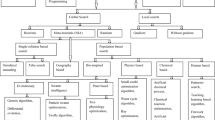Abstract
To balance the hydraulic and anti-clogging performances for labyrinth-channel emitters, a multi-objective optimization was performed to improve the structure of trapezoidal labyrinth channels. Two variables, pressure loss coefficient (PLC) and passage rate of particles (PRP), were proposed to evaluate the hydraulic and anti-clogging performances, respectively. The Pareto fronts of PLC and PRP were calculated using the elitist non-dominated sorting genetic algorithm version II (NSGA-II). The results show that the optimal fronts are obtained through 100 generations evolution. The associated key parameters D/W and H/D are constant, while S/H and α are different for each front. In addition, the approach to obtain a trade-off solution from these fronts was developed by arranging different weights for the two variables. This approach is very suitable for structural optimization of labyrinth channels with the same shape but different dimensions.







Similar content being viewed by others
References
Adin A, Sacks M (1991) Dripper clogging factors in waste water irrigation. J Irrig Drain E-ASCE 117(6):813–826
Cararo DC, Botrel TA, Hills DJ et al (2006) Analysis of clogging in drip emitters during wastewater irrigation. Appl Eng in Agric 22(2):251–257
De Almeida CDGC, Botrel TA, Smith RJ (2009) Characterization of the microtube emitter used in a novel micro-sprinkler. Irrig Sci 27(3):209–214
Deb K, Pratap A, Agarwal S, Meyarivan T (2002) A fast and elitist multiobjective genetic algorithm: NSGA-ΙΙ. IEEE T Evolut Comput 6(2):182–197
Goldberg DE (1989) Genetic algorithms in search, optimization, and machine learning. Addison-Wesley Publishing, Boston
Griffiths WD, Boysan F (1996) Computational fluid dynamics (CFD) and empirical modeling of the performance of a number of cyclone samplers. J Aerosol Sci 27(2):281–304
Hoekstra AJ, Derksen JJ, Vandenakker HEA (1999) An experimental and numerical study of turbulent swirling flow in gas cyclones. Chem Eng Sci 54(13–14):2055–2065
ISO Committee (2003) Clogging test methods for emitters ISO/TC 23/SC 18
Keller J, Karmeli D (1974) Trickle irrigation design parameters. Transaction ASAE 17(4):678–684
Kirnak H, Dogan E, Demir S (2004) Determination of hydraulic performance of trickle irrigation emitters used in irrigation systems in the Harran Plain. Tr J Agric For 28(4):223–230
Li GY, Wang JD, Alam M (2006) Influence of geometrical parameters of labyrinth flow path of drip emitters on hydraulic and anti-clogging performance. Trans ASABE 49(3):637–643
Madramootoo CA, Khatri KC, Rigby M (1988) Hydraulic performances of five different trickle irrigation emitters. Can Agric Eng 30(1):1–4
Ould A, Bouya A, Yamamoto T, Fujiyama H, Miyamoto K (2007) Assessment of emitter discharge in microirrigation system as affected by polluted water. Irrig Drain Syst 21(2):97–107
Padmakumari O, Sivanappan RK (1985) Study of clogging of emitters in drip systems. In: Proceedings of the third international drip/trickle irrigation congress, Sanfrancisco, CA, USA: ASAE, pp 80–83
Ravina I, Paz E, Sofer Z, Marcu A, Shisha A, Sagi G (1992) Control of emitter clogging in drip irrigation with reclaimed wastewater. Irrig Sci 13(3):129–139
Srinivas N, Deb K (1994) Multiobjective optimization using nondominated sorting in genetic algorithms. Evol Comput 2(3):221–248
Takahiro A, Shougo H (2006) Transition of the flow in a symmetric channel with periodically expanded grooves. Chem Eng Sci 61(8):2721–2729
Wadsworth HM (1989) Handbook of statistical methods for engineers and scientists. McGraw-Hill, New York
Wei ZY, Tang YP, Zhao WH, Lu BH (2007) Rapid structural design of drip irrigation emitters based on RP technology. Rapid Prototyping J 13(5):268–275
Zhang J (2009) Evaluation methods of both hydraulic and anti-clogging performances and structural optimization of labyrinth channels. Distertation, Xi’an Jiaotong University
Zhang J, Zhao WH, Wei ZY, Tang YP, Lu BH (2007a) Numerical and experimental study on hydraulic performance of emitters with arc labyrinth channels. Comput Electron Agric 56(2):120–129
Zhang J, Zhao WH, Tang YP, Wei ZY, Lu BH (2007b) Numerical investigation of the clogging mechanism in labyrinth channel of the emitter. Int J Numer Meth Engng 70(13):1598–1612
Zhang J, Zhao WH, Tang YP, Lu BH (2010) Anti-clogging performance evaluation and parameterized design of emitters with labyrinth channels. Comput Electron Agric 74(1):59–65
Acknowledgments
This work is financially supported by the Fundamental Research Funds for the Central Universities and the Program for Changjiang Scholars and Innovative Research Team in University (No. IRT0646).
Author information
Authors and Affiliations
Corresponding author
Additional information
Communicated by T. Trooien.
Rights and permissions
About this article
Cite this article
Zhang, J., Zhao, W., Tang, Y. et al. Structural optimization of labyrinth-channel emitters based on hydraulic and anti-clogging performances. Irrig Sci 29, 351–357 (2011). https://doi.org/10.1007/s00271-010-0242-4
Received:
Accepted:
Published:
Issue Date:
DOI: https://doi.org/10.1007/s00271-010-0242-4




